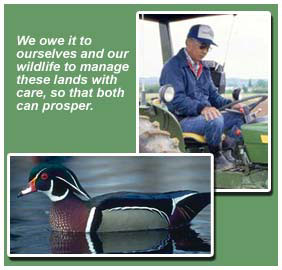Whether cropland, pastureland or rangeland, half of the United
States is a “working landscape.” These lands provide food and fiber
for Americans and people around the world. From Maine to California,
lands that support agriculture are a critical natural resource that
help
sustain people, wildlife and local economies. In fact, much of
the wildlife that make being outdoors so special when we hike, camp,
bike or fish are dependent upon the wetlands and grasslands found on
our nation’s working landscapes. However, these lands are not
inexhaustible, as we have witnessed in the past with tragedies such
as the Dust Bowl. Communities and wildlife throughout the nation
depend on sound management of working lands now and in the
future.
Many farmers and ranchers are aware of the role they can play in
restoring and conserving America’s grasslands and wetlands. However,
they simply don’t have the tools or the resources necessary to
undertake these conservation practices. For this reason, the National
Wildlife Federation is working to give private landowners the information
and resources they need to help restore and conserve wildlife
habitat on their lands.
One tool to help farmers and ranchers protect America’s working
lands is the upcoming reauthorization of
the Farm Bill. The 2002 Farm Bill provides an opportunity to improve
and expand the USDA conservation programs that provide farmers and
ranchers with the financial and technical assistance necessary to
undertake practices which benefit people, wildlife and water
quality. With the right components, the National Wildlife Federation
feels the 2002 Farm Bill will guarantee the health of working
landscapes upon which people and wildlife depend.
is the upcoming reauthorization of
the Farm Bill. The 2002 Farm Bill provides an opportunity to improve
and expand the USDA conservation programs that provide farmers and
ranchers with the financial and technical assistance necessary to
undertake practices which benefit people, wildlife and water
quality. With the right components, the National Wildlife Federation
feels the 2002 Farm Bill will guarantee the health of working
landscapes upon which people and wildlife depend.